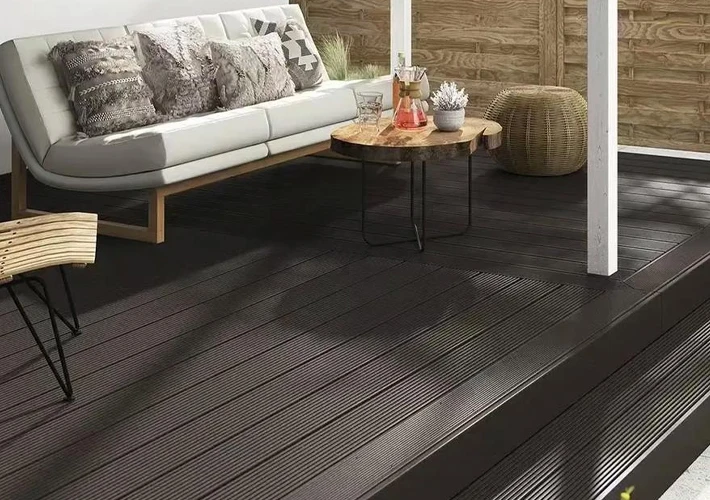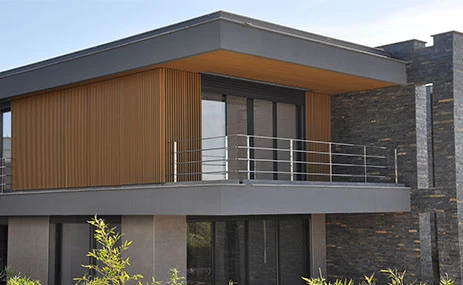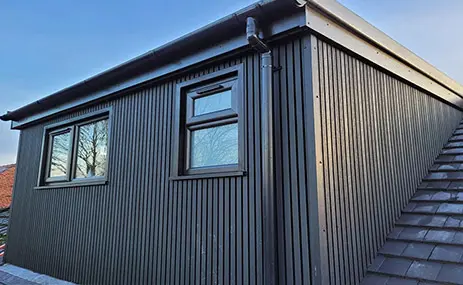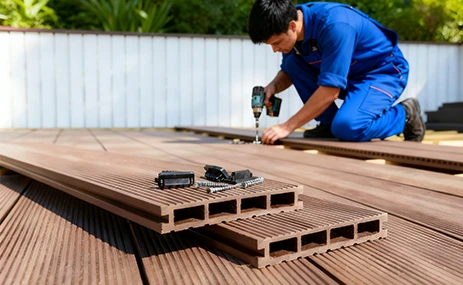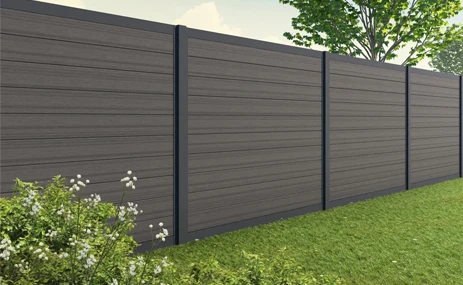Composite decking has become one of the most popular outdoor flooring materials for modern construction and landscaping projects. Known for its durability, aesthetic appeal, and low maintenance, it provides a sustainable alternative to traditional timber decking. But what exactly is composite decking made of?
In this comprehensive guide, we’ll explore the materials used in composite decking, how they are combined, their properties, and why this blend makes composite decking the ideal choice for residential, commercial, and public outdoor spaces.
Table of Contents
ToggleIntroduction to Composite Decking
Composite decking—also called WPC decking (Wood Plastic Composite decking)—is an engineered outdoor material made from a combination of wood fibers and plastic polymers, enhanced with additives to improve stability, color, and performance.
Unlike natural wood, composite decking resists rot, cracking, and warping. It maintains a consistent appearance over time with minimal maintenance, making it a preferred material for patios, pool surrounds, gardens, balconies, and public walkways.
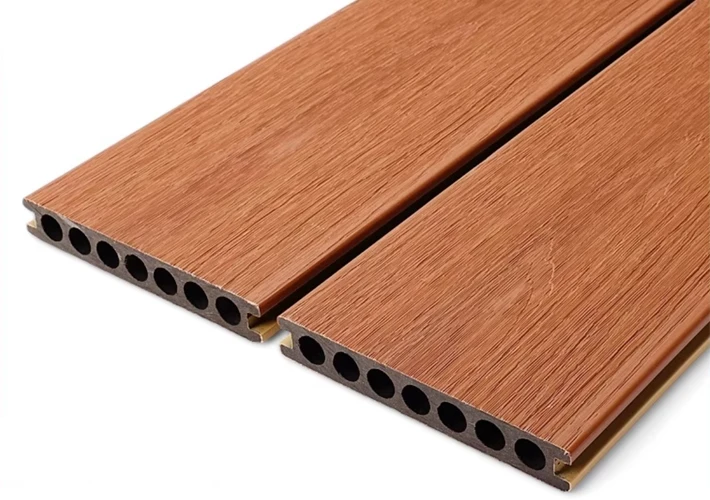
Core Components of Composite Decking
To understand what makes composite decking so durable, let’s look at its three main material categories:
(1) Wood Fiber or Wood Flour
Wood fibers are the organic component of WPC decking. These fibers are typically derived from:
- Hardwood species such as oak, maple, or teak
- Softwood species like pine or fir
- Recycled sawdust from wood manufacturing processes
The wood fiber content in composite decking usually ranges from 50% to 65% by weight.
Key Benefits:
- Provides natural appearance and texture
- Enhances rigidity and strength
- Increases screw-holding ability
- Contributes to the realistic wood grain surface
The source and quality of the wood fibers significantly influence the deck’s appearance and mechanical properties. Manufacturers in China, for example, often use finely milled wood powder to ensure a smooth surface and uniform density.
(2) Plastic Polymers
The plastic component acts as a binder and protective layer, encapsulating the wood fibers to prevent moisture absorption, decay, and insect damage.
Common plastics used in WPC decking include:
a. Polyethylene (PE)
- Most widely used polymer in composite decking
- Offers excellent flexibility and weather resistance
- Derived from recycled plastic films, packaging, or milk jugs
- Common in residential-grade decking
b. Polypropylene (PP)
- Provides higher heat resistance and rigidity
- Used in commercial or heavy-duty decking applications
- Has a slightly harder surface than PE-based composites
c. Polyvinyl Chloride (PVC)
- Creates 100% plastic composite decking (also known as capped PVC decking)
- Completely free from wood content
- Offers maximum moisture resistance and minimal expansion
Typical Plastic Ratio:
Plastic polymers make up 25%–40% of the total composite decking composition, depending on the product type.
(3) Additives and Modifiers
Additives play a crucial role in improving the overall performance of composite decking. Even though they only account for 5–10% of the formula, their effect on quality and longevity is significant.
Common additives include:
| Additive Type | Function |
|---|---|
| Coupling Agents | Improve adhesion between wood fibers and plastic molecules |
| UV Stabilizers | Prevent fading from sunlight exposure |
| Color Pigments | Provide natural wood-like colors such as teak, walnut, or grey |
| Antioxidants | Protect the polymer chains from degradation |
| Lubricants | Enhance extrusion efficiency and surface smoothness |
| Anti-fungal Agents | Prevent mold and mildew growth in damp environments |
| Foaming Agents (optional) | Used in co-extruded decking to reduce density and cost |
Together, these additives ensure that composite decking maintains its stability, color, and structure for 15–25 years or more.
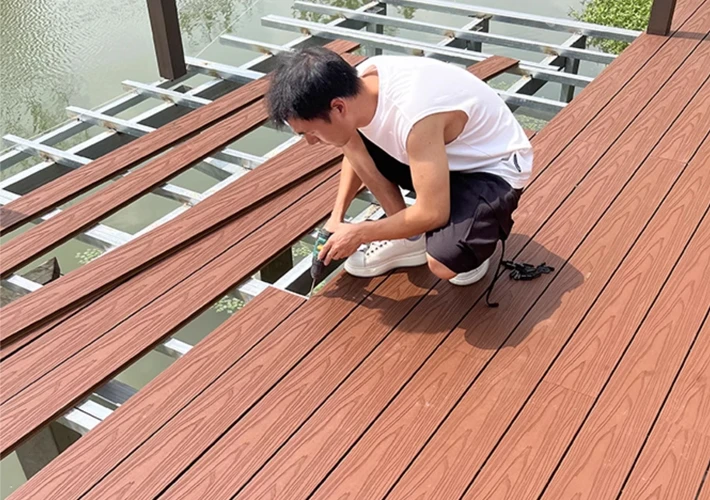
Proportions of Composite Decking Materials
The ratio of wood, plastic, and additives determines the decking’s strength, weight, and surface performance.
A typical high-quality composite decking board may consist of:
| Component | Percentage by Weight |
|---|---|
| Wood Fiber | 55%–60% |
| Plastic (PE or PP) | 30%–35% |
| Additives | 5%–10% |
This balance allows the material to maintain a natural wood feel while being protected by the durability of plastic.
Types of Composite Decking Based on Material Structure
Composite decking materials can be further categorized according to their internal structure and production method.
(1) Traditional Composite Decking (Uncapped WPC)
- Made entirely from mixed wood fibers and plastic
- Surface is sanded or brushed for texture
- More affordable but may fade slightly under UV exposure
(2) Capped Composite Decking (Co-extruded WPC)
- Features an outer protective polymer shell
- The core contains WPC material, while the cap layer is 100% plastic
- Offers superior stain, scratch, and fade resistance
- Highly popular in North America and Europe
(3) Solid vs. Hollow Composite Decking
| Type | Description | Benefits |
|---|---|---|
| Solid Decking | Full material structure | More stable, stronger load-bearing capacity |
| Hollow Decking | Honeycomb or round hole design | Lightweight, cost-effective, easier to install |
Solid composite decking is ideal for high-traffic areas, while hollow boards are suitable for residential projects where cost and ease of installation are priorities.
The Manufacturing Process of Composite Decking
Understanding the materials is only half the story. The production process also determines product quality and durability.
Step 1: Raw Material Preparation
Wood powder and recycled plastic are collected, cleaned, and dried to remove moisture and impurities.
Step 2: Mixing and Compounding
Materials are blended in a specific ratio along with coupling agents, pigments, and stabilizers. A twin-screw extruder ensures uniform mixing and dispersion.
Step 3: Extrusion
The mixed material is melted and forced through a mold to create the decking profile. The shape and dimensions are precisely controlled for consistency.
Step 4: Surface Treatment
The extruded boards are brushed, embossed, or sanded to replicate wood grain textures. For co-extruded decking, a protective plastic cap layer is added.
Step 5: Cooling and Cutting
Boards are cooled, calibrated, and cut into standard lengths (usually 2.2m to 5.4m).
Step 6: Quality Testing
Tests include:
- Tensile strength
- Water absorption
- Slip resistance
- Color fastness
- Thermal expansion
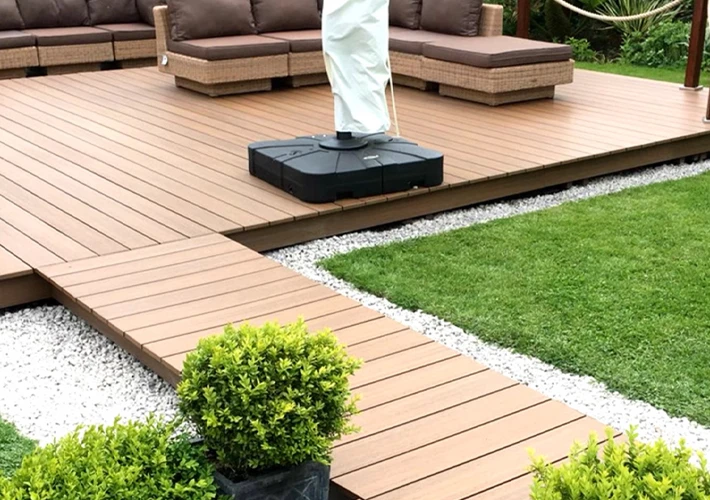
Advantages of Composite Decking Materials
Because of its advanced material composition, composite decking offers several advantages over traditional wood and pure plastic decking:
| Feature | Composite Decking | Natural Wood | Pure Plastic |
|---|---|---|---|
| Water Resistance | Excellent | Poor | Excellent |
| UV Resistance | High | Low | High |
| Maintenance | Low | High | Low |
| Slip Resistance | High | Medium | High |
| Aesthetic Appeal | Natural wood look | Natural | Artificial |
| Durability | 15–25 years | 5–10 years | 10–15 years |
| Eco-friendliness | Made from recycled materials | Depends on source | Limited |
Material Innovations in Modern Composite Decking
Over the last decade, manufacturers—especially those in China—have invested in R&D and advanced extrusion technologies to enhance composite decking performance. Some material innovations include:
a. Bamboo Fiber Reinforced WPC
Bamboo fibers replace traditional wood fibers, offering higher strength, lower weight, and improved water resistance.
b. Mineral-Filled Composite Decking
Adding calcium carbonate or talc enhances stiffness and reduces expansion rates in hot climates.
c. 3D Embossed Co-Extrusion
Advanced embossing technology makes the grain pattern more realistic and permanent, providing a luxury wood texture without fading.
d. Recycled HDPE-Based Decking
High-density polyethylene sourced from recycled plastics creates a stronger, more sustainable board with minimal carbon footprint.
How Material Quality Affects Decking Performance
The quality of raw materials directly impacts the lifespan and safety of the decking.
| Material Aspect | Poor-Quality Impact | High-Quality Impact |
|---|---|---|
| Wood Fiber | Uneven density, cracks | Stable structure, smooth surface |
| Plastic Polymer | Brittleness, deformation | High toughness, UV resistance |
| Additives | Color fading, mold growth | Long-lasting color, anti-fungal protection |
A professional WPC decking factory in China ensures strict quality control from raw material sourcing to finished product testing, guaranteeing consistent performance across batches.
Environmental Benefits of Composite Decking Materials
Composite decking contributes to environmental sustainability in multiple ways:
- Recycling: Uses waste wood fibers and plastics that would otherwise end up in landfills.
- Longevity: Reduces the need for frequent replacement compared to timber.
- No Harmful Chemicals: Free from formaldehyde and toxic paints.
- Energy Efficiency: Modern extrusion lines minimize waste and emissions.
This makes composite decking a green choice that aligns with global environmental standards such as ISO 14001 and CE certifications.
Applications of Composite Decking
Thanks to its balanced material structure, composite decking is suitable for a wide range of applications:
- Residential spaces: balconies, terraces, gardens
- Commercial projects: resorts, hotels, restaurants
- Public spaces: parks, walkways, docks, pool decks
- Architectural facades: wall cladding and exterior decoration
Its flexibility in design and installation makes it a universal outdoor material trusted by builders and architects worldwide.
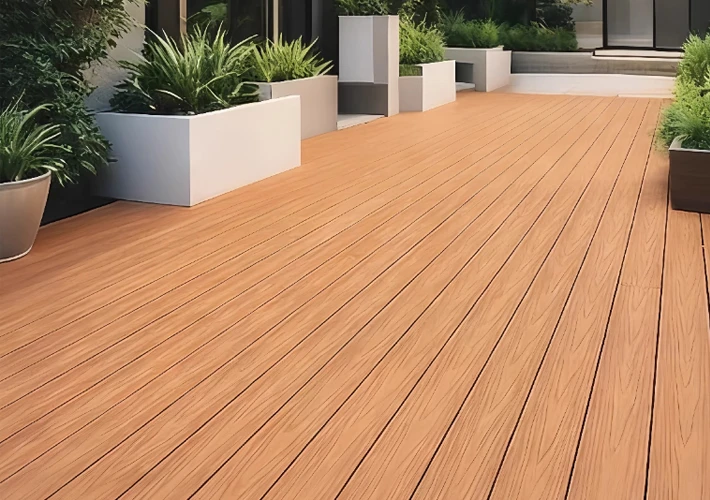
How to Choose the Right Composite Decking Material
When selecting composite decking, pay attention to:
Material composition (PE, PP, or PVC-based)
Wood fiber content and fineness
Co-extrusion or uncapped design
UV and color stability additives
Warranty and testing standards
Reliable manufacturers can provide material reports, SGS testing results, and sample boards for evaluation before purchase.
Conclusion: The Perfect Blend of Nature and Technology
Composite decking is the result of combining the warmth of natural wood with the resilience of modern polymers. The materials—wood fibers, recycled plastics, and carefully engineered additives—work together to create a decking solution that’s sustainable, long-lasting, and visually stunning.
For importers, distributors, and project contractors, understanding these material components helps identify high-quality suppliers and cost-effective solutions.
As one of the leading composite decking manufacturers in China, we specialize in producing high-quality WPC decking using advanced extrusion technology and premium raw materials.
- Over 10 years of manufacturing experience
- Customizable formulations based on climate and project needs
- Global export services to Europe, North America, and the Middle East
- OEM/ODM solutions for private label brands
Our composite decking combines 50% wood fiber, 35% HDPE plastic, and premium additives to deliver the perfect balance of strength, beauty, and environmental protection.
If you are looking for a reliable WPC decking supplier in China, contact us today for free samples and a factory quotation.


